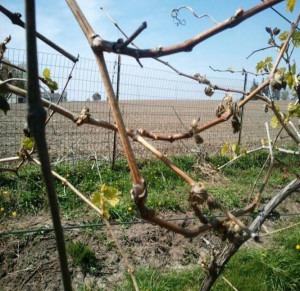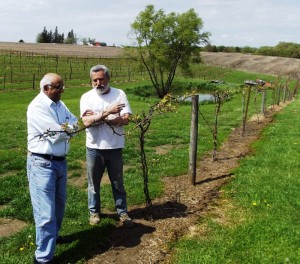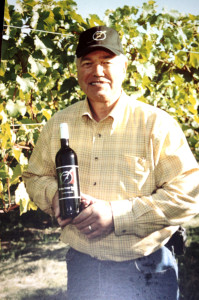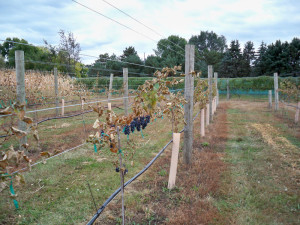Nipping Jack Frost First This Spring
Last year at this time the upper Midwest was riding a wave of warmth. It would last several weeks, break thousands of temperature records, and spur grape vines to bud break that turned to heart break in April. This year February at least was closer to normal, but nerves may get edgy if those March temperatures start to climb and it looks like Jack Frost will surely be back this April or early May.
Many growers will be planning to get the jump on Jack with the pre-emptive use of an innovative plant nutrition spray shown to harden off buds and vines for several degrees of frost mitigation. KDL® (Potassium Dextro-Lac®) was brought to the attention of grape growers in early winter of 2012 by John Marshall, whose Great River Vineyard is in Lake City, Minnesota. His articles in the ‘Notes from the North” newsletter of the Minnesota Grape Growers Association and in Midwest Wine Press related the experiences in his vineyard and others using KDL for frost protection.
His follow-up articles in April and July added further information about the use of KDL and this reason for his continuing discussion:
‘“when growers report and supply me with photographic evidence of their successful use of KDL in previous frost events, complete with adjacent untreated blocks that were demolished in the frost, I felt it would have been irresponsible of me not to have brought these experiences to growers’ attention. Something is going on here!”
Now a number of other growers are providing their own accounts of last spring, and in one case, the previous fall. One vineyard even caught the eye of Iowa State University Extension viticulturists last year when Iowa grower John Burns reported what happened at his Barrel Head Winery near Dubuque. As reported in the April 14, 2012 edition of ISU’s Wine-Grower-News, Burns sprayed a tank mix of KDL and Sysstemâ„¢-CAL the day prior to two nights of frost when temperatures reached 25-27 degrees. Only vines where he ran out of the mixture were damaged.
‘I knew we were expecting a hard frost, and since I had heard a little about KDL and that it can’t hurt the vines because it’s actually a nutrient, I ordered it,” says Burns. ‘I got it about 10 in morning and that night the temperature dropped into the 20s. Before the frost hit I got it all done in one application, but I ran out when I got to a 120-foot row of grapes behind the shop. By then I only had enough to spray half of it, so there was a place where one section had KDL applied and the rest didn’t, which made for an inadvertent treated vs. control test. After the freeze, the side with KDL was absolutely perfect, but the side that was not sprayed had brown leaves all over the place.
‘Dr. Mike White and Dr. Murli Dharmadhikari from the Iowa State University Extension came to have a look and take photos. After Dr. White published one of the photos of the Marechal Foch vines other growers called and came by later in the year. They could not believe how good condition our grapes were in.”
A Lot to Lose
‘We’re an estate winery. We’re not a big outfit flush with cash,” says Burns. ‘We get maybe 8 to 10 tons of grapes a year. So when I look at a frost coming, I’m looking at disaster. We know we will get it in the shorts if our crop freezes. Without grapes, we’re done. I don’t have any arrangement to buy grapes, so if I lose my crop I have nothing to sell, no tourists in here tasting and buying my wines.”
And no chance for more awards. In the 2012 Mid-America Wine Competition, Burns’ wines won gold, silver and bronze, including the first Iowa winery to win a gold in Methode Champenoise.
Other growers in Iowa, Minnesota, Nebraska, Illinois, Michigan and North Carolina reported similar experiences using KDL and Sysstem-CAL, often but not always used in a tank mix with KDL. Both are products of Agro-K Corporation of Minneapolis.
‘KDL’s is unique in the way potassium is linked to a molecular sugar complex that can quickly penetrate plant tissue to increase potassium and sugar levels within the plant,” explains Larry Shafer, Agro-K vice president. ‘KDL puts the plant into a more ‘winterized’ or hardened mode so tissue is better able to survive cold temperatures, usually down to the upper 20s, depending on the duration of a frost event. The addition of calcium linked to a highly mobile phosphite ion fortifies the developing shoots and buds for faster recovery.”
Shafer notes that even in the same vineyard every frost event is different, with temperature and duration among the variables that impact damage levels.
‘The further along the shoots and buds are, the harder they are to protect,” Shafer says. ‘KDL has been used successfully for frost mitigation for many years, but growers must keep in mind that these frost and crop variables can lessen its efficacy for this usage. Nonetheless, KDL does offer a level of protection and can be used as inexpensive insurance in a frost strategy.”
Surviving Buds Carried the Season
Dick Faltz, whose Fox Valley Winery is near Oswego, Illinois, says that in 2012 bud break came very early, about March 21.
‘We knew we were in for trouble,” he says. ‘We had two killing freezes after bud break, the last one on April 11. After that one we decided we would have to prune off the dead buds that had sprouted. Luckily we had pruned in March and had 4 extra buds on each pruning shoot. The earlier frost had killed them down to two buds per shoot. We knew that if any more frosts were coming we were in a desperate situation.
‘So I did some research and came across KDL and talked with Larry Shafer, who said that when you get bud break again if there is a freeze threat, put on KDL 24 hours ahead and see what happens. We had nothing to lose except the whole crop if we didn’t try that. We were scheduled to get another freeze about April 19, so we put on the KDL 24 hours ahead of it. The temperatures got down to 26 degrees in the vineyard. But there was no bud loss or damage whatsoever to the vines. Instead, we had primary buds on new growth that had popped up and fantastic bloom and fruit set. We carried between 6 and 10 tons of grapes per acre. We feel we were very fortunate.”
The state research center 16 miles away reported light to average fruit set last year. Some growers in southern Illinois with the same varieties as Faltz had a much worse year, and a couple lost their crop entirely or had sharply reduced fruit set because almost all of it was secondaries.
‘There just is not much a grower can do but sit back and wait and spray the day before the freeze threat,” says Faltz. ‘You still have to use your sense of viticulture and do the right things from a practices standpoint. But there must be something to that dextrose and lactose that adds some antifreeze to the vine. Some of our varieties like Seval Blanc, Vignoles and Frontenac ran well ahead of schedule for harvest. After harvest we put some energy into the vines and let them go to sleep happy.”
Frost Protection in Nebraska
Eric Nelson’s six-acre Oak Creek Vineyards, started in 1998, is near Raymond, Nebraska and features cultivars Edelweiss, La Crosse, Dechaunac, and Brianna.
‘The vineyard always has problems with frost,” says Nelson. ‘It’s just the way it is situated. I’ve used KDL the past three years to enhance our brix numbers prior to harvest and decided in 2012 I would order it early so I could also use it if we had any freeze events. The formula I use includes KDL, Sysstem-CAL and Spray-Tech Oil.
‘The frost protection we had with KDL was phenomenal. In mid- to late-April we had the frost events. We ended up having one day at 26 degrees and 2 days at 27, and overall we got hit three times. What we did before each event was apply our pre-frost recipe within 24 hours of the start of the frost. We had some younger vines we did not spray because they were not going to fruit anyway, and a lot of those vines froze almost down to the ground.
‘Everything we sprayed with the Agro-K formula seemed to be relatively unscathed. There was a little bit of damage, but there was a day-and-night difference compared to the vines we did not spray. Agro-K also has their recipe for use after a hard frost, so each time we came back with that spray immediately following the frost event. It gives the vines some extra food and what they need to recover.”
Our 2012 Edelweiss, which is the #1 grape in Nebraska and the best-selling wine, was up 20 percent from 2011. That’s a pretty important grape to our industry, and it is really susceptible to frost, 2-4D and other issues. What we’ve been doing the last two years is producing more pounds of grapes per vine than the neighboring vineyards. So I feel pretty good about using the Agro-K program. We sell almost all of our grapes to Nebraska’s largest winery, James Arthur Vineyards, which is just a mile east of us.
His Vines Made a Premium Crop
Gary Balcome’s Spring Creek Vineyard sits up on a bluff 28 miles northeast of Rochester, Minnesota near Millville. His four acres of grapes consist of Marquette, Frontenac Gris, La Crescent, King of The North, Bluebell and Somerset Seedless.
‘Last April we got word a frost was expected, and our vines were still in the bud stage. So we sprayed KDL,” Balcome recalls. ‘Then as we came up to Easter and we knew we would be away from the vineyard when there might be another frost, we sprayed KDL a second time when the vines were still in bud stage.
‘After the frosts we found there were only two plants out of the whole vineyard that showed some sort of damage, and sometimes we’ve lost more than that to gophers. It was a whole lot less damage than I was expecting back in March, when I feared we could lose hundreds of plants. After that second KDL application we had increased flowering and more fruit set as the season went along. The third week in May the vines were all at full bloom, and we went right into veraison the first week of July.”
‘By mid-August the grapes were three weeks ahead of average and had a huge amount of fruit on,” Balcome says. ‘Part of that was due to more vines coming into maturity this year. But I really think KDL also had a lot to do with it. It was a crazy, very warm year.”
‘Our yield tripled in 2012. We received 10 cent per pound premium above contract price. What appeared to be a growing season in jeopardy turned into a dream growing year. I really cannot be sure if KDL was responsible for my frost protection, I do know that there was minimal damage to my vineyard and our yield tripled to premium quality.
Most of our grapes are sold to Villa Bellezza winery at Pepin, Wisconsin across the Mississippi River from us.”
Calisota Vineyards: 28 Degrees at 5:00 a.m.
One of the growers John Marshall wrote about is Don Dinesen, whose Calisota Vineyards is near Cannon Falls, Minnesota. Dinesen developed his interest in growing grapes while working for an oil company in California for 25 years. His experience fighting off a frost event came on September 15, 2011.
‘I sprayed 3,000 vines with KDL about 12-15 hours before the frost,” he recalls. ‘We have two blocks of the same grapes that are adjacent to each other, but since one block was still a year from meaningful production, we didn’t treat it to prevent frost damage. When I walked out of the house at 5 a.m. the morning of the frost event, I went out to the vineyard and saw that the temperature was sitting at 28 degrees.
‘The grapes looked OK, but daybreak would be the real test to see what happened. During that day and the next day I surveyed all of the grapes, both treated and untreated, and found that I had not suffered any appreciable frost related damage on the treated vines, but had experienced total loss of leaves on the untreated vines. We then picked all of the grapes from the untreated vines and made a blush wine out of them, which turned out to be a very good experiment. We were able to keep the treated block of grapes healthy and picked a good crop three weeks later. None of this would have been possible without the KDL.”
Other growers tell similar stories. Whether the frost arrives late in the spring as it did in 2012 or early in the fall as in 2011, growers know the risk. And they may be staring Jack Frost in the face again this spring.







In general, it would be nice if there was a print button on articles to get a printer friendly version to easily and print and save articles for future reference and to pass along to others.
Chris,
Thanks for bringing up the issue of printing articles. We’re in the development stage of a digital magazine version of Midwest Wine Press that will make it easier to save articles. In the meantime, it’s usually possible to copy the article from the internet and paste it to a Word document using the standard “cut and paste” commands or a mouse.